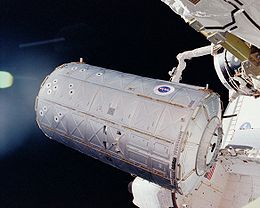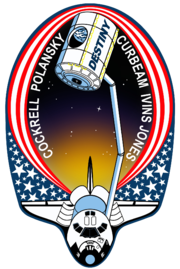STS-98

Atlantis manoeuvres the Destiny module into position with its RMS
|
|
| Mission type | ISS assembly |
|---|---|
| Operator | NASA |
| COSPAR ID | 2001-006A |
| SATCAT no. | 26698 |
| Mission duration | 12 days, 21 hours, 21 minutes, 0 seconds |
| Distance travelled | 8,500,000 kilometers (5,300,000 mi) |
| Orbits completed | 171 |
| Spacecraft properties | |
| Spacecraft | Space Shuttle Atlantis |
| Launch mass | 115,529 kilograms (254,698 lb) |
| Landing mass | 90,225 kilograms (198,912 lb) |
| Payload mass | 14,515 kilograms (32,000 lb) |
| Crew | |
| Crew size | 5 |
| Members |
Kenneth D. Cockrell Mark L. Polansky Robert L. Curbeam Marsha S. Ivins Thomas D. Jones |
| Start of mission | |
| Launch date | 7 February 2001, 23:13 UTC |
| Launch site | Kennedy LC-39A |
| End of mission | |
| Landing date | 20 February 2001, 20:33 UTC |
| Landing site | Edwards Runway 22 |
| Orbital parameters | |
| Reference system | Geocentric |
| Regime | Low Earth |
| Perigee | 365 kilometers (197 nmi) |
| Apogee | 378 kilometers (204 nmi) |
| Inclination | 51.6 degrees |
| Period | 92 minutes |
| Docking with ISS | |
| Docking port |
PMA-3 (Unity nadir) |
| Docking date | 9 February 2001, 16:51 UTC |
| Undocking date | 16 February 2001, 14:05 UTC |
| Time docked | 6 days, 21 hours, 14 minutes |
 L-R: Robert Curbeam, Mark Polansky, Marsha Ivans, Kenneth Cockrell and Thomas Jones |
|
STS-98 was a 2001 Space Shuttle mission to the International Space Station (ISS) flown by Space Shuttle Atlantis. STS-98 delivered to the station the Destiny Laboratory Module. All mission objectives were completed and the shuttle reentered and landed safely at Edwards Air Force Base on 20 February 2001, after twelve days in space, six of which were spent docked to the ISS.
Mark C. Lee was scheduled to fly as Mission Specialist 1 on his fifth trip to space, but due to undisclosed reasons, he was removed from this flight. His replacement was Robert Curbeam.
The crew continued the task of building and enhancing the International Space Station by delivering the U.S. Destiny Laboratory Module. The Shuttle spent six days docked to the station while the laboratory was attached and three spacewalks were conducted to complete its assembly. The mission also saw the 100th spacewalk in U.S. spaceflight history. STS-98 occurred while the first station crew was aboard the new space station.
NASA began a tradition of playing music to astronauts during the Gemini program, which was first used to wake up a flight crew during Apollo 15. Each track is specially chosen, often by their families, and usually has a special meaning to an individual member of the crew, or is applicable to their daily activities.
![]() This article incorporates public domain material from websites or documents of the National Aeronautics and Space Administration.
This article incorporates public domain material from websites or documents of the National Aeronautics and Space Administration.
...
Wikipedia

